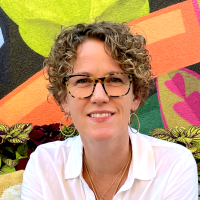I gave someone some questionable advice recently.
A colleague is in an all-too-familiar, borderline abusive work situation with a hostile manager. While everyone else was telling her to set boundaries, offer polite but vague refusals, track data to support her argument with HR, take medical leave, see a counselor, invest in home gym equipment, and practice self-care—I suggested that she double down on her consideration to quit—without a backup plan.
Before I continue, I want to fully acknowledge the privileges that afford me this line of thinking—I am a white, well-educated, professional woman with a supportive partner. I understand that many, many people are prisoners to a barely survivable wage or a barely survivable relationship with no safety net of any kind. As much as I want to have the answer for these scenarios, too, I don’t and won’t pretend to.
However, the thing we all do have in common, relative though it may be—is fear. And fear is a relentless jailer.
In every echelon and corner of our worlds, we accommodate a broken system that requires working too many hours, little expectation of personal boundaries, and embracing the myth that our well-being is less important than the work that we do: whether we do it as CEOs, middle managers, entrepreneurs, parents, partners, adult children, or all of the above. In accepting this narrative, we continue to reinforce the scaffolding of the system that cripples us. Why? Because we are constantly fed a toxic brew of fear and false gratitude.
>> You should be grateful you have this work, this health insurance, and your sense of self-worth as defined by your job.
>> You should be grateful you have this stable, if imperfect, partner.
>> You should be grateful for____ fill in the blank.
>> Because just imagine what it would be like not to have these things!
We are told what our success should look like and, by implication, what forms our failure would take. Rather than being encouraged to know for ourselves what those things look and feel like, we are conditioned to use the opinions of media, history, family, and friends to define our boundaries and our beliefs about what is worthy of our gratitude and our sense of safety.
Other key components that often go undiscussed when we face the prospect of leaving an untenable situation of any kind, are the feelings of disappointment, shame, and their often unacknowledged bedfellow—grief.
We embark on our journeys with a set of hopeful expectations. When things start to fall apart, we initially look to the circumstances outside of our control, but inevitably, we eventually look inward.
Because we have spent a lifetime absorbing the message that we are worth less than the system, we default to blaming ourselves for the demise of our situation. We must have expected too much in the first place; we must not have tried hard enough. In case the practical, logistical, material fears of quitting the known weren’t enough, we also saddle ourselves with guilt, self-doubt, and the risk of potentially disappointing future decisions.
Is there anything more heartbreaking than the death of hope?
Rather than suffer this bitterness, we often choose to diminish our need for escape. We convince ourselves that we can keep going on the prescribed crumbs of self-compassion we are allowed: massages, meditation, chocolate, alcohol, affairs…
It is painfully ironic that we often become deeply mired in the energy-draining churn of avoiding the very changes that would save us. We will compromise until we grind ourselves to dust for others, but seldom practice radical compassion in the form of radical action for ourselves.
No doubt this is because we have never been taught what radical self-compassion feels like. Rather, we are inured to fear, caution, and the crucial importance of staying inside the city walls for the greater good. Just stay here and be the best prisoner you can be.
Attempting escape is folly.
>> You don’t have enough resources.
>> You don’t know where you are going.
>> You don’t know what comes next.
But what if, rather than providing safety, the must-have backup plan is just another cultural myth that keeps us playing small? Whose agenda are these fear-inducing boundaries serving? When it is more often than not at the cost of our mental, physical, and emotional well-being—I don’t think it is ours.
Suppose we are willing to increase our tolerance for uncertainty, to really drill down and get familiar with our own, genuine, self-described fear boundaries. Might we also increase the scope of our potential new realities? There are entire realms of possibilities that we don’t even let ourselves approach, because we have never even considered examining the corresponding levels of fear. It’s simply not done. What if some of our unexamined fears are nothing more than the man behind the curtain in the “Wizard of Oz?”
What if we are actually incredibly brave, and it is everyone else that is afraid?
I am not so naïve as to think there are not also practical considerations that go into significant life changes. But, I challenge all of us to question them thoroughly for “false fears,” before blindly accepting them into our decision-making matrix.
The following is the scenario I presented to my colleague:
Imagine quitting tomorrow with no exit plan in place.
Imagine all the frightening things that might involve: loss of income, loss of stability. Think yourself into the darkest, most uncomfortable scenario you can imagine. How does it make you feel?
Now, flip the switch to your current situation and feel into that.
Which of the two scenarios feels better/worse?
If being in total free fall doesn’t feel worse—quit. Now. Save yourself. Leaving this situation while you still have some of your self, some of your sanity, some of your health means that you still have your personal resources at your disposal. Imagine using all the energy you are expending in this terribly negative environment and channeling it inward as you recover, heal, and plan your next steps.
If, after making the comparison, you land on the side of “it is better to stay,” you will likely discover a new wellspring of energy with which to execute vital self-care and compassion while you make a longer-term exit plan.
This “extreme” thoughts and fears exercise is not fun, but it does force a new relativity scale for our fears and some ultimately helpful focus. A seemingly simple shift in perspective can produce tectonic change. Making a fully self-informed decision, regardless of which one, releases our energy from the churn and makes it available to us again for taking action.
Reaching deep within ourselves, past all of our worst fears for our truth, allows us to find our foundations. Perhaps, we burn everything down to the ground and start completely over; perhaps, we shore up our foundations and make some overall structural improvements. But either way, we are strengthened because we have made a self-informed choice.
When we take the moment to ask ourselves who we are without externally-imposed fears, we discover empowering and truly self-inspired answers—our answers.
~


 Share on bsky
Share on bsky





Read 10 comments and reply